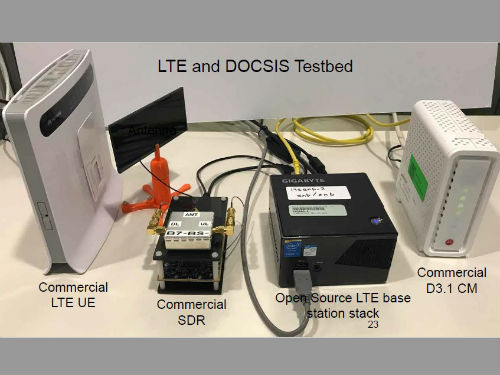CableLabs-Cisco Trial Successfully Extends Bridge Between DOCSIS and LTE

Serving up a potential breakthrough that could factor heavily into cable’s future deployments of small cell networks, CableLabs and Cisco Systems said recent tests of a proposed technique called the “Bandwidth Report” (BWR) prove that super-low latencies can be achieved by extending a technical bridge between DOCSIS and LTE.
While the goal of the BWR test was to achieve upstream latencies of sub-5 milliseconds, the test, following some manual tuning of this “pipelining” of the DOCSIS and LTE schedulers, reduced latency to about 1.1 milliseconds.
“So, it worked,” John Chapman, a fellow at Cisco Systems who is also CTO of the company’s Cable Access unit, proclaimed Thursday during a CableLabs-hosted webinar entitled Enabling Cable Networks for Mobile Backhaul.
The test, they said, shows that DOCSIS can become a viable backhaul for LTE and could play a major role as cable operators start to develop LTE-based small cell networks, and as they also look to complement their mobile and wireless strategies using the CBRS [Citizens Broadband Radio Service] 3.5 GHz band.
RELATED: Comcast Wants to Test CBRS in Philly
Notably, the BWR proposal is also extensible to future 5G networks, Chapman explained.
But the issue that’s being solved with BWR is to reduce inherent upstream latency in DOCSIS networks to a level that is required for 4G and 5G small cells – certainly beneath the 5 millisecond mark.
Multichannel Newsletter
The smarter way to stay on top of the multichannel video marketplace. Sign up below.
So, in order to play that key backhaul role, DOCSIS must provide a low latency path between neighboring small cells, Jennifer Andreoli-Fang, a distinguished technologist at CableLabs, said.
BWR, a method that was described in detail at last fall’s SCTE/ISBE Cable-Tec Expo in Denver, aims to overcome a mismatch between the schedulers for DOCSIS and LTE by having them work together and hit the latency goal.
And there’s quite a chasm to overcome.
For the DOCSIS upstream, 5 milliseconds has been the “minimum latency,” though it’s typical to see it at 11 milliseconds, and grow to 30 milliseconds or 50 milliseconds if there is contention in the upstream, Chapman said.
The goal with the BWR proposal is to shrink that number down 2 milliseconds or lower.
Fundamentally, BWR enables the DOCSIS and LTE schedulers to talk to each other through a technique called “pipelining,” with BWR serving as a request into the DOCSIS system.
“It’s fundamentally an API into the DOCSIS scheduler” that allows an external component, like a small cell, to ask for a certain number of bytes at some future point in time, Chapman explained.
While this allows the LTE and DOCSIS scheduling systems to communicate, the BWR method essentially “hides” the DOCSIS latency beneath LTE and reduces the latency by taking advantage of the predictive nature of the LTE scheduler, he said.
For the trial, CableLabs and Cisco set up a physical LTE and DOCSIS test bed that includes a commercial LTE user device talking to an open source LTE small cell that was being backhauled on a commercial DOCSIS 3.1 modem and a Cisco cBR-8 CCAP/CMTS.
A small amount of code was inserted into the LTE MAC layer, which didn’t change the scheduler, but instead sent out a scheduling decision that is put into the form of a BWR message, Andreoli-Fang explained.
That message was then sent out on the DOCSIS uplink and received by an API on the cBR-8. A series of packets were then sent from the LTE user device to the CMTS, and the results showed that the method provided a clear latency advantage.
The results showed that “DOCSIS is well positioned as a viable backhaul technology for LTE,” Chapman claimed. “The path to success is actually having mobile and DOCSIS technologies working together as one."
The proof-of-concept is now moving to the next phase, as CableLabs has kicked off a committee that will explore the possible specification of the BWR protocol and have it become part of the DOCSIS scheduling system, Andreoli-Fang said.
“It’s something we can define at CableLabs,” Chapman said, adding that LTE will also have the ability to write to that API.
What’s not known is when BWR might become a more formal piece of the puzzle.
Fellow webinar panelist, Craig Cowden, SVP of wireless technology at Charter Communications, stressed that there’s time for that to develop, noting that the FCC is still working out rules for the use of CBRS and that the broader product ecosystem still needs to come together.
RELATED: Charter Puts Wireless Broadband to the Test (subscription required)
“There is some time, for us anyway, to see this evolve,” he said.
But the underlying work is “incredibly important as we talk about how we could be able to enable our DOCSIS HFC networks for true fixed mobile convergence, particularly as we talk about 4G, and especially 5G, where those lower latency requirements are essential,” Cowden said earlier in the webinar.
